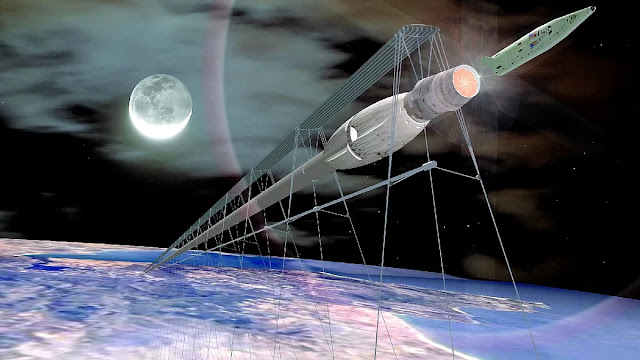A space elevator is "a bridge to the entire solar system."
 |
A space elevator concept. Wikimedia |
The space elevator — a structure that reaches into the sky —
might feel like a distant, farfetched concept, but it could be closer than we
think.
In an op-ed for Scientific American, Physics professor
Stephen Cohen at Vanier College in Montreal, Quebec, said he believes the
sci-fi-like technology could be a reality within "the next two or three
decades."
Cohen describes the space elevator as "a cable
stretching from Earth to space, along which people and cargo can easily
travel." In his op-ed, he claims engineers and scientists are breaking new
ground when it comes to designing these massive structures that could
revolutionize the way we access space.
Why build a space elevator?
Space elevators have the potential to massively reduce the
cost and energy required to go to space. Companies like SpinLaunch are already
testing new, potentially ground-breaking technologies that could dramatically
slash the costs of sending small satellites and scientific payloads to space.
However, space elevators could launch people, cargo, and
scientific payloads into space, so they would have the added benefit of
boosting human spaceflight and space tourism.
With space elevators, "the word “space mission"
would be replaced by "transit," as trips to space become routine and
mostly independent of weather conditions," Cohen writes. "Transits
involving humans would be safer than current practices, whereby astronauts must
accept a nonnegligible risk to their lives with each launch."
"A space elevator becomes a bridge to the entire solar
system. Release a payload in the lower portion, and you orbit Earth, but do so
in the upper portion, and you orbit the sun, all without fuel."
How would a space elevator work?
Cohen explains that his fascination with space elevators
began when he was discussing thesis topics with Professor Arun Misra, the
leading space expert in the mechanical engineering department at McGill
University, in 2004.
Misra told him about the space elevator concept, a
62,130-mile-long (100,000-km) cable that extends up into the sky from the
Earth's equator and is attached to a satellite in a geosynchronous orbit —
meaning it orbits at the same speed as the Earth and, therefore, flies over a
fixed location.
The concept would also use mechanical climbers to travel to
different altitudes from Earth's surface. Depending on the altitude at which a
capsule or spacecraft would be released, it would either start orbiting the
Earth or the Sun or fall back to Earth.
Different concepts over the years have suggested different
types of mechanical climbers. One space elevator concept, for example, would
utilize maglev rail transporters to traverse the massive space cable at very
high speeds.
As Cohen points out in his piece, the material required for
such a cable would have to be 50 times stronger than steel, so space elevators
are impossible with our current technology. In the meantime, he and "a
handful of other people in the world are pretending that this problem will be
solved and tackling other engineering aspects of space elevators while we
wait."
Though Cohen doesn't work directly on the material aspect of
space elevator technology, he believes we could be a mere decade or two away
from having the material required to make space elevators a reality. Scientists
are constantly working on making stronger materials and technologies for
various reasons related to global infrastructure projects. This work could one
day result in the advent of space elevators. It would be a development that
could open space up to the masses and help humanity reach farther into the
cosmos than ever before.




0 Comments